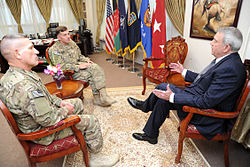This article needs additional citations for verification .(January 2021) |
| Camp Eggers | |
|---|---|
| Kabul in Afghanistan | |
 Camp Eggers on Anzac Day in 2007 | |
| Site information | |
| Owner | Afghan Armed Forces United States Armed Forces |
 | |
| Site history | |
| Built | 2004 |
| In use | 2004–2015 |
Camp Eggers was a United States military base in Kabul, Afghanistan, located near the US Embassy and the Afghan Presidential Palace. The camp was named after Captain Daniel W. Eggers, a US soldier from the 1st Battalion, 3rd Special Forces Group (Airborne), Fort Bragg, North Carolina, who was killed by an improvised explosive device (IED) along with three other soldiers on 29 May 2004 near Kandahar. Camp Eggers closed in 2015 as a part of the partial withdrawal of U.S. troops from Afghanistan (2011–2016). [1]
